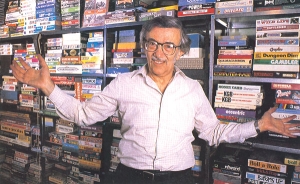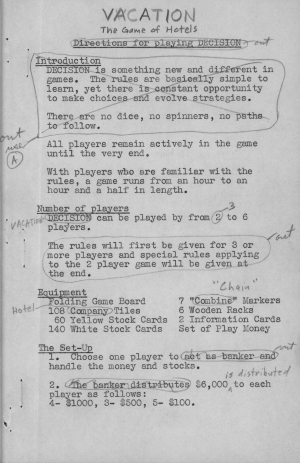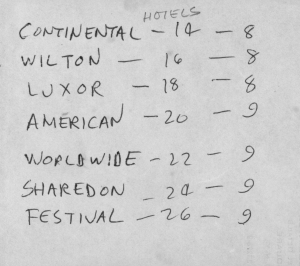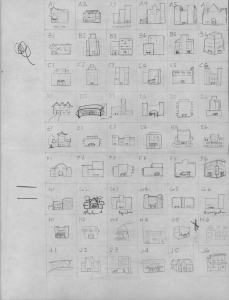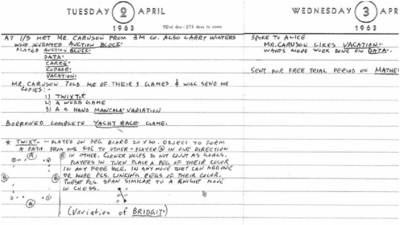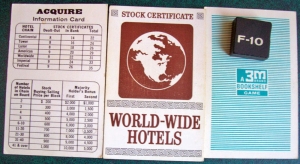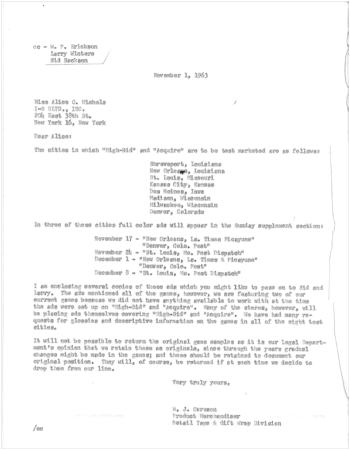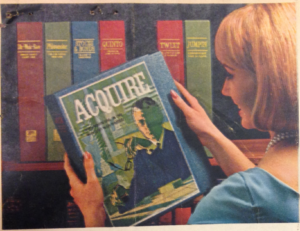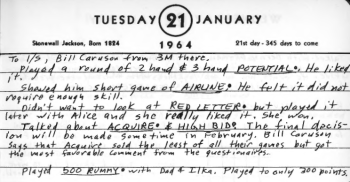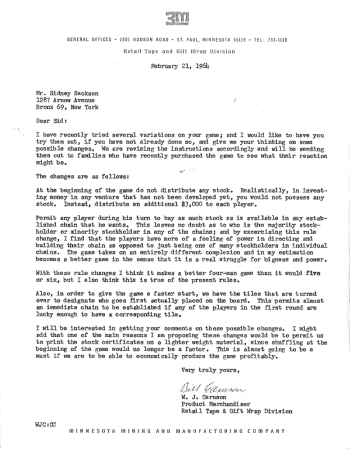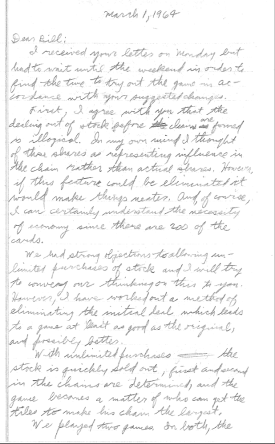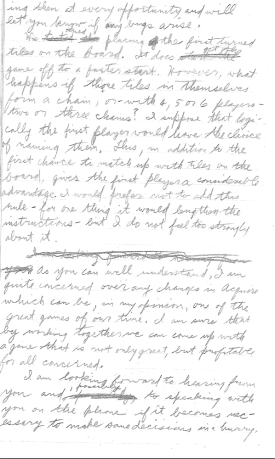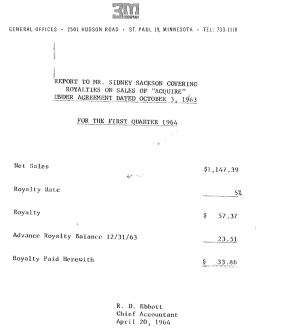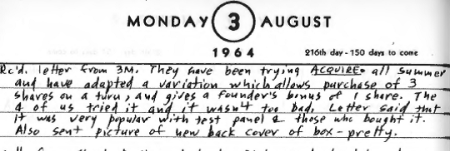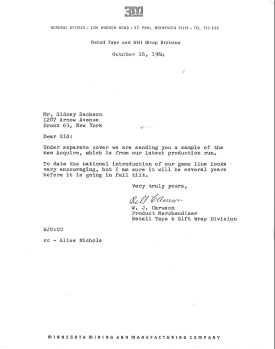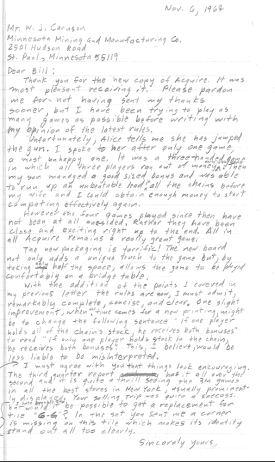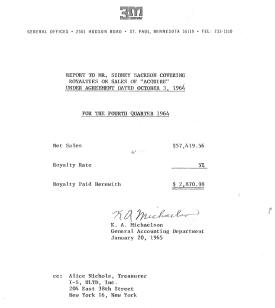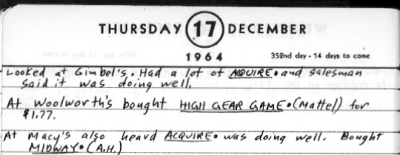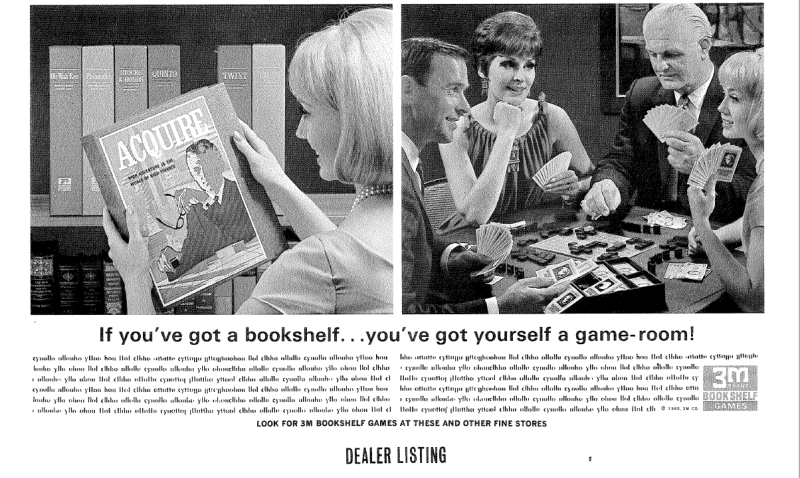NOTE: The information in this article about the origin of the game of ACQUIRE has been derived from copies of articles that I purchased from the Strong Museum of Play, or more specifically, the Sid Sackson Collection at the Brian-Sutton Smith Library and Archives of Play located within the Strong Museum.
The Strong Museum houses a large collection of Sid Sackson artifacts, which allowed me the ability to pour through numerous personal diaries, letters, and manuscripts to try to construct an article that helps tell the story of Sid Sackson’s greatest creation, the game of ACQUIRE.
I was alerted to the Strong Museum by Günther Rosenbaum of Germany when he sent me some material he had purchased from the museum. I used one of the articles he sent me, simply labeled, "Biographical Note," and dated June 2010, to construct the personal information on Sid. I have also added some of my own observations and juxtapositions to help piece together this history as there is some information that just can’t be found.
I would like to offer a special thanks to Mrs. Dale Friedman, Sid Sackson's daughter, whose generous donation to the Strong Museum of all these papers made this article possible. She has allowed me to recreate Sid's amazing journey at the birth of this game. I want to also extend a thank you to Sid, God rest his soul, whose meticulous indexing of his diaries made this endeavor extremely easier. Thank you, Sid, for helping me make your memory live on.
~ Lloyd Solon
In an undated game manuscript, Sid Sackson wrote down the beginnings of a new game idea he called, “DECISION.” He started the manuscript by writing an introduction in the instructions:
“DECISION is something new and different in games. The rules are basically simple to learn, yet there is constant opportunity to make choices and evolve strategies.”
Little did he know that he was laying the ground work for what would become his best and most successful game idea out of the hundreds that he would produce in his lifetime.
As a child Sid was obsessed with games. His mother would purchase him a new game every week. He always wanted to improve them to make them better or just create a new game from their origins. Through the years he amassed an extremely large collection of games as he would buy games outright and also be given games to test on a very frequent basis. He would intensely study all the games he received to see if they were interesting or to determine if he could improve on, or just use, the idea.
He also ordered game patents from the Library of Congress, as a normal routine, to study games from the past. He was always looking to create new games by improving on ideas that were good ideas, but needed a little help to improve their appeal. When he became bored with the game of LOTTO, he changed it into a game he could play on his own building historical empires. That was the idea that would eventually lead to the game of ACQUIRE.
Sid Sackson was highly respected in the game community. In this same undated manuscript, Sid used a pencil to cross out the name of “DECISION” and rename the game idea “VACATION – The Game of Hotels.” This change was done after June 3, 1959 because that is the date that Sid submitted the idea for the game of DECISION to his gaming agent, Alice, at I-S Unlimited. DECISION was submitted to his agent on that day in June 1959 along with three other game ideas, CARRE, HIGH SPIRITS, and RED LETTER.
When Sid changed the manuscript from DECISION, he meticulously went through the entire manuscript and changed the word “companies” to “hotels,” changed the names of the companies to names of hotels, and changed the word “combines” to “chains.” He also wrote a new introduction for the game:
“VACATION is an introduction to the fabulous world of the luxury hotel, in the U.S., in the Caribbean, and throughout the exotic places of the world.”
He proceeded to draw a game board that listed a different city in the world on each of the 108 squares on the board. Sid also put a pattern of designations on the squares that range from A-1 to I-12, which is similar to the way that a Microsoft Excel Spreadsheet is set up today. He grouped the cities from different continents on certain sections of the board.
In another drawing, he depicted the tiles for the corresponding squares to have the name of the city along with a picture of a hotel relating to the design of the city and the square designation. Sid was very thorough in everything he did, drawing a detailed picture on all 108 tiles. This built a symmetry that would evolve during game play as the board would begin to have the appearance of different continents as the chains grew in size.
Sid’s idea consisted of using seven hotel chains. Each hotel would possess different amounts of shares in their stock portfolios and 60 shares would be randomly dealt out to the players before the game started.
The manuscript reads as follows: The number on the left represents the total number of white card stocks for that hotel that will be available for purchase during game play. The number on the right designates the total number of yellow card stocks that are shuffled and distributed. This gave a total of 200 Stock Cards that included 60 being distributed before game play and 140 being left for purchase during game play. Since the players were given an equal share of the 60 distributed stock cards at the beginning of the game, they could only purchase one stock per turn during the game.
| Hotel | White Card Stock Available for Purchase | Yellow Card Stock Shuffled and Distributed | Total Stock |
| Continental | 14 | 8 | 22 |
| Wilton | 16 | 8 | 24 |
| Luxor | 18 | 8 | 26 |
| American | 20 | 9 | 29 |
| Worldwide | 22 | 9 | 31 |
| Sharedon | 24 | 9 | 33 |
| Festival | 26 | 9 | 35 |
This manuscript also shows the struggle Sid had with trying to write rules for a two-player game. When he changed the name, he also crossed out his attempt to construct rules for such a game and at the top of the manuscript he changed it to read, “From 3-6 players.” DECISION, and subsequently VACATION, were ideas that were too difficult to corral to just two players. To this day, four players are optimum for a balanced game.
On Tuesday March 26, 1963 Sid was contacted by his agent, Alice at I/S, concerning the quest by the 3M Company to test market three new games in the Midwestern United States and that they were looking for more games. The 3M Company, Minnesota Mining, & Manufacturing, had recently hired William Caruson to create a board game division within the company.
The 3M Company had recognized that due to technological advances in the work place, combined with newly evolving labor laws, the average American had more leisure time. They also recognized that most board games were directed towards children and not adults. So, the 3M brain trust decided that they would try to fill the new void in the lifestyle of the average American family by creating a series of adult “bookshelf” games that were directed towards increased social interaction. The company was looking for games that could fit into a box that was the same size as a normal book so that the games would fit on the bookshelf.
By the next day, Sid was busy creating a box design for his game of VACATION. Three days later on March 29, 1963, Sid took the game of CARRE and VACATION to I/S Unlimited. By April 2nd he was already meeting with Bill Caruson at the offices of I/S Unlimited. The meeting also included Larry Winters, who had created a game called “AUCTION BLOCK” that 3M also had an interest in.
During that meeting, Sid gave 3M the game manuscripts for DATA, CARRE, COPADE, and VACATION. By the next day, Caruson provided feedback. He liked VACATION, but thought DATA needed some work. By April 22nd 3M had rejected the idea of CARRE, but two days later on the 24th, Sid was notified that they liked the idea of VACATION.
3M wanted approval to test market VACATION that upcoming Christmas season. Yet even though the 3M Company was asking for approval, they still were not willing to commit to the game. They stated that they would make a decision by mid-May.
On May 17, 1963, Sid was notified that 3M had sent money to hold the rights to the game of VACATION for a longer period of time. On June 11, 1963, Sid was contacted by Alice. She told him that Caruson had called and said that they “want to make changes to VACATION to cut costs and said they would send a letter with explanations.”
NOTE: I could never find this letter in any of the 1963 correspondence. It is never mentioned in Sid’s Diary or in the folder of 3M Correspondence for 1963. Also, the correspondence between I/S Unlimited and Sid is missing for the years 1963 and 1964. This became a reoccurring problem during my research for all changes that were made by 3M during this period.
Many things may have been discussed through phone conversations, and therefore, there is no history. I did find a letter in the 1964 3M correspondence that addressed changes. So I would assume that, other than the name and the deviation from his original drawings for board and tiles, the discussion of major changes occurred after the release of the test market games.
~ Lloyd Solon
After that June 11th Diary entry, Sid did not mention the game again until September 9, 1963. On that day he wrote, “3M wants to change VACATION to ACQUIRE.” I can only assume, without access to further information, that the 3M Company already had a working idea for a game called ACQUIRE and then stumbled across the idea that Sid sent them.
I make this assumption because the artwork for the eventual mass production box for the game of ACQUIRE is dated 1962 and they didn’t get Sid’s idea until March of 1963. 3M had probably developed the artwork the year before and then just tailored it to Sid’s idea. The first test market games of ACQUIRE were dated with a copyright of 1963, but when it came time to mass produce the game in 1964, 3M chose to use the 1962 copyright of the artwork on the outside of the box and the 1963 copyright of Sid’s idea on the inside box with the rules.
3M had mentioned that they wanted to make changes to VACATION to cut costs, so by making the name change to fit some previously constructed artwork made sense to save money. Yet, by comparing Sid’s original manuscript to the test market games that were produced, we can see some of the other changes made by 3M.
Sid had envisioned a board with squares that designated different cities around the globe and were clustered into continents. 3M made the board into a picture of a world map and the squares only had the squares designation. Sid had also envisioned tiles that had various forms of hotels printed on them, but the 3M Company made the tiles out of wood with the squares' designations printed on them.
The chipboard method of tiles that was designed by Sid would probably have been cheaper to produce after the artwork expense, and Sid actually suggested that method in a later letter, but I believe 3M used the wood tiles because they were the same wood tiles that the company was using in other bookshelf games such as PHLOUNDER and QUINTO. Since 3M could use the same type of wood tile in all three games, they could reduce their costs overall.
3M changed the names of Wilton and Sharedon to Tower and Imperial. They also decided to print all 200 of the stock cards on white card stock instead of printing 140 on white card stock and the sixty to be shuffled and dealt on yellow card stock. This move also saved them money in production.
By September 20, 1963, 11 days after the notification of the name change, Alice of I/S Unlimited was already writing a counter offer to a contract offered by 3M for the game of ACQUIRE. 3M had constructed a contract offer that was heavily skewed in their favor. The first issue that was addressed was the fact that 3M had offered a limit of royalty payments in the amount of $25,000. Sid’s agents would accept no less compensation than royalties for the life of the game. Considering the continuing life of the game of ACQUIRE, this was a very wise move.
3M also wanted Sid to “assign all interest” in the game of ACQUIRE to them. His agents wanted them to only have the right to “make, use, and/or sell” the game. His agents also wanted the rights to the game of ACQUIRE to come back to the inventor when the company decided to discontinue the “production, marketing, and promotion” of this game. It may have been beneficial to ask for the right to take the game back from the company if the inventor was dissatisfied with the company's efforts to produce, market, and /or sell the game since the contract and rights are stated to continue if 3M chose to sell its interest to another company.
One of the last issues in the contract was to address possible competition or “knock-offs” of the game. 3M wanted an automatic suspension of royalty payments to the inventor if they had to enter litigation against a knock-off game. I/S Unlimited argued that the royalty payment should be reduced by the amount of the cost of litigation. Either way, Sid or his heirs would be responsible to pay for litigation and it would not be the responsibility of the game company to protect the game against competition.
It only took 19 days and Sid was writing in his diary on October 9, 1963 that he “Went to I/S Ultd. Inc. about ACQUIRE contract.” Two days later he writes, “Signed contract for ACQUIRE (Vacation).” It appears that he was still trying to adjust to the name change since it had only been proposed a month prior. Since this was Sid’s first major contract for one of his game ideas, the last month was most likely a huge whirlwind for him. 3M had latched onto his idea, incorporated it into another idea they had been developing, and were poised to get it on the market rapidly.
3M was obviously sending him many updates of their progress. The game was progressing rapidly and was heading for market in just a couple of months. On October 21, 1963, just ten days after signing the contract, Sid wrote a letter to Bill Caruson. The main objective that he had with all the whirlwind of changes that were happening with his game was that he thought 3M shouldn’t market it as a “Stock Market” game. He wrote in the letter:
“Acquire is, of course, much more than merely a matter of buying and selling stock. I think it would be desirable to de-emphasize the stock market angle and instead get across the idea that in Acquire players really have the elbow room to wheel and deal and plan, not being limited by chance devices such as dice, cards, or spinners.”
Eleven days later on November 1, 1963, Bill Caruson of 3M wrote a letter to Alice Nichols at I/S Ultd telling them the cities in which the first games of ACQUIRE will be test marketed. The eight cities that were chosen were all in Mid-America. They were Shreveport and New Orleans, Louisiana, Madison and Milwaukee, Wisconsin, Des Moines, Iowa, Kansas City, Kansas, St. Louis, Missouri, and Denver, Colorado. The choice of these cities was probably in relation to the location of the 3M Corp in Minneapolis, Minnesota.
In the same letter, Mr. Caruson addressed a request for return of the “original game samples.” Obviously Sid had asked to have his original work, which he had given to 3M to jump start the game, returned to him. Mr. Caruson wrote:
“It will not be possible to return the original game samples as it is our Legal Department’s opinion that we retain these as originals, since through the years gradual changes might be made in these games; and these should be retained to document our original position. They will, of course, be returned if at such time we decide to drop them from our line.”
Mr. Caruson also wrote a letter to Sid on the same day stating, “We should have finished games sometime next week, and I will get one in your hands just as soon as possible.”
Three days later, on the 14th of November 1963, Sid wrote in his diary that he received artwork and instructions. By November 27th, Mr. Caruson was writing a letter stating that they had the games completed and they would send one to Sid. Caruson complained about the artwork on the money and said it could be corrected on future production runs. There was also some problem with the box sleeve that made it crooked. 3M was rushing to get this corrected so the ones that hit the stores did not look as bad.
By November 30th, Caruson tells Sid that his copy is on the way. Sid’s agent, Alice, received her copy by December 2nd. Sid didn’t get his until the 10th. He wrote a letter to Caruson on the 13th stating that he was a little upset with the Post Office.
Sid was very impressed with this first game. He also outlined mistakes that he had noticed and changes he would like to see made. One of the changes Sid suggested was:
“One pointer I would like to see in the tips is to keep on the alert for the opportunity to pick up a “second bonus” cheaply. Very often players will get into “ruinous” battles for “first” in one chain while neglecting the chance for “second” in other chains from just the purchase of one or two stocks.”
This advice never did make it into the rule booklet, but it still remains solid advice today.
In a December 21, 1963 diary entry Sid writes, “Played ACQUIRE with Dad & Dana.” Sid was first notified on April 24, 1963 that 3M was interested in his game called “VACATION.” Now just 8 months later, he is playing his game. His original idea has been modified slightly, and the name was changed, but it was his game, produced by a major manufacturer. On December 31st, at the end of that year, 3M had already sold $1,029.80 in games (approximately 148 games). Sid’s 5% royalty netted him $51.49 (approximately 7 games). The game of ACQUIRE had come to life.
1963 was a whirlwind for Sid Sackson. He began the year as a little known game inventor and ended the year with one of his game ideas being sold in major stores in eight large cities in the U.S. But was the final product of ACQUIRE really going to be Sid Sackson’s game?
There is a part of humanity that sees more than others. We tend to call them “artists.” The problem with artists is they are usually starving while they are trying to sell their art. This is where the corporate world takes control.
Artists want to be known for their creations; corporations have the money to make this dream a reality. The downfall is that the corporations then own the rights and creativity from the artist and usually leave them with little or nothing. The Beatles do not control the usage rights to their music; neither does Taylor Swift, and Sid Sackson could do little as 3M changed his idea to fit their vision for profit.
To recap, Sid had an idea for a game called VACATION. 3M had an idea for a game called “ACQUIRE. 3M’s idea must not have been too good. Sid’s idea was brilliant. So, corporate America decided to take Sid’s creativity and fit it into their mold.
Sid had an idea that the game would play out on a board that depicted different continents and the tiles would reflect different cities around the world. 3M had other games they were looking at for the Bookshelf Series and they wanted to fit tiles from those games into Sid’s idea, so they altered Sid’s idea to be able to use those same tiles.
Sid had the idea to distribute stock at the beginning of the game to cause mystery throughout the game as to who is in control, and also at the same time, increase the mystery and strategy by staggering the number of stocks in each company. 3M had obviously already made the decision, when they put out the test market games in December of 1963, that they were going to shy away from Sid’s idea of distributing stock at the beginning of the game. Evidence of this was when they printed all the stocks on the same color paper instead of white and yellow as Sid had designed.
Sid wrote in his diary on January 18, 1964, “(Received) statement from 3M on ACQUIRE. Disappointing.”
It is interesting to ponder what Sid was thinking at this moment. The test market games had only been on sale for the month of December and they sold $1,029.80, or in today’s money, approximately $8,300. Sid’s 5% commission was $51.49, or in today's money, approximately $420. Not bad for some extra income in a month. Yet it may have been all the hype for the game, and the fact that it was in such major stores, that Sid had higher expectations.
On January 21, 1964 Sid wrote in his diary, “To I/S Bill Caruson from 3M there. Talked about ACQUIRE. Final decision will be made sometime in February. Bill Caruson says that ACQUIRE sold the least of all their games but got the most favorable comment from the questionnaires.”
3M had already taken a lot of liberties with Sid’s idea, and more than he even knew at that time, yet they still proceeded to tell him that they weren’t sold on his idea. Caruson tells him this even though the 3M promotional picture that was used in December of 1963 to promote the game of ACQUIRE already depicted a different box and board than the one that was being sold in the test market games. 3M was already progressing on the game of ACQUIRE, but they wouldn’t tell Sid.
The rapid progression that was happening at 3M became evident when Larry Winters, the designer of the game AUCTION BLOCK, received six copies of ACQUIRE a few days later by mistake that were heavily damaged. He brought them over to Sid’s house on the 7th of February. Sid sorted through them the next day and was able to make five complete games.
By the 12th of February, 3M had sent Sid six more good copies. These games were different variants of the game. 3M was testing many different versions and wanted Sid to try them out and offer his feedback.
On February 21st, Sid received a letter from Caruson. This letter covered many different aspects about 3M’s desire to make changes to the game. It also illustrated how fast things were moving at 3M since the games had arrived to Bill Winters over a month before, yet it is not until now Caruson is telling Sid the reason for them.
“I have recently tried many variations of the game; and I would like to have you try them out, if you have not already done so, and give me your thinking on some possible changes.”
This letter finally explains the reason for sending six games to Sid. This is also where the idea to not distribute stock at the beginning of the game is introduced.
“At the beginning of the game do not distribute any stock. Realistically, in investing money in any venture that has not been developed yet, you would not possess any stock. Instead distribute an additional $3,000 to each player.”
Then the letter took a turn into the corporate world of thinking. The next suggestion for the game that Caruson offered was a classic view from the top.
“Permit any player during his turn to buy as much stock as is available in any established chain that he wants.”
Caruson goes on to say, “The game takes on an entirely different complexion and in my estimation becomes a better game in the sense that it is a real struggle for bigness and power.”
This letter addressed another aspect of the game that was sometimes, but not always, clarified in the rules of later editions of the game.
“Also, in order to give the game a faster start, we have the tiles that are turned over to designate who goes first actually placed on the board.”
Mr. Caruson also explains another reason why he does not want to distribute stock at the beginning of the game.
“I am proposing these changes would be to permit us to print the stock certificates on lighter weight material, since shuffling at the beginning of the game would no longer be a factor. This is almost going to be a must if we are able to produce the game profitably.”
This introduction of “lighter weight material” into the game of ACQUIRE didn’t come to fruition until the 1966 production runs. It was not a good decision. It seemed that the games produced in 1966, with stock certificates that didn’t have wax coating, were a factory error. This letter suggests that it was a corporate decision to try and save money.
This move by 3M severely cheapened the game of ACQUIRE with those production runs. Just because 3M eliminated the idea that the cards would be shuffled and dealt out doesn’t mean the remaining cards weren’t going to be handled continuously and wear out quickly. It is an age old trade off in business: Do you make cuts in production costs hoping to maintain, or increase, sales with an inferior product?
Three days later on February 24th Sid wrote in his diary, “They want to make changes to ACQUIRE to eliminate dealing shares at the start so that paper can be used instead of cardboard. They want to allow purchase of as many shares as you wish on a turn. This is horrible. I was thinking of having 25 “stock option” cards which are dealt out at the beginning, instead of shares.”
The next day, on the 25th, Alice from I/S called saying she had received a letter from 3M and Sid wrote in his diary, “They are continuing with the game…told her of yesterday’s letter. Prepared a rough set of “stock options” cards for ACQUIRE.”
3M had allowed Sid to linger for over a month wondering if they were going to continue with his idea. 3M knew they were going to continue; they just used this month to make Sid sweat and to gain leverage on their ability to further change his original ideas without his opposition. Yet still he held steadfast in his idea to keep mystery in the game with his attempt to make stock options. It was his concession for losing the shuffle and distribution of cards at the beginning of the game. He wanted to keep his creativity and balance in the game.
By February 29th, Sid was tirelessly attempting numerous versions of ACQUIRE as he wrote in his diary, “Played ACQUIRE with BB, Dana, & Dale with unlimited stock purchases. No good. Then the 4 of us played with a bonus of 2 shares for starting a chain. (See 3M correspondence.) Good. Played without Dale. Then in evening 5 hand with Phil, Annette, & Dana. All worked well.”
BB is Sid’s wife. Dana is Sid’s son; Dale is his daughter. The dedication of this family to Sid’s dream was very admirable. This was something that could become enormous for this family.
The next day, March 1st, Sid wrote a letter to Caruson. He wanted to give his feedback on the various editions that 3M had sent, but mainly he wanted to sell the new ideas he had developed within the last two months.
“First of all I agree with you that the dealing out of stocks before the chains are formed is illogical. In my own mind I thought of these shares as representing influence in the chain rather than actual shares. However, if this feature could be eliminated it would make things neater, and of course, I can certainly understand the necessity of economy since there are 200 of the cards.”
Sid was losing his ability to create mystery in the game and 3M simply just wanted to create inexpensive game pieces.
“We had strong objections to allowing unlimited purchases of stock and I will try and convey our thinking on this to you. However, I have worked out a method of eliminating the initial deal which leads to a game at least as good as the original, and possibly better. In general what was missing was the opportunity to make choices, the chance to overcome the disadvantages of unlucky tiles by astute purchasing of stock.”
In this last statement resides the crux of the question of will ACQUIRE be a “good” game or will it be a “great” game? Sid was trying to make it a great game, while 3M was trying to make it a good game. Sid’s ideas and suggestions were based on the aspect of fairness to all players in the game, while 3M was more concerned about economies of scale.
It was at this point, in the history of the game of ACQUIRE, that expediency of time to get the product to the market did not allow adequate time for thoughtful thinking. Sid’s idea of distributing stock at the beginning of the game was his way of giving the players “the opportunity to make choices, and the chance to overcome the disadvantages of unlucky tiles by astute purchasing of stock.” Sid was concerned about keeping the game fair.
It would appear, looking at the makeup of Sid’s original idea, that the necessity of dealing stocks at the beginning of the game was predicated on balancing the practice that players are essentially “given” stocks at the time of merging chains. Sid and Caruson both agreed that giving out stocks before companies are formed is illogical.
They should have then realized that giving out stocks to a vanquished company, which in some cases allows them to assume majority in the conquering company, is also illogical. Without the balance of the free shares distributed in the beginning of the game, then the rule that allows players to trade stocks from the vanquished chain 2 for 1 in the conquering chain increases the “disadvantages of unlucky tiles” and also hampers “the opportunity to make wise choices.”
These two issues were paramount in Sid's mind to create a great game. It seems plausible that Sid initially envisioned that the 2-for-1 rule would give the players a semblance of the stock market by giving them the ability to trade stocks. Yet this rule often ends up in giving a player an unrealistic, and lucky, way of gaining control of the game. By simply eliminating the 2-for-1 rule, Sid would have eliminated his need to distribute stocks at the beginning of the game or even now to try and conceive the practice of “bonus” stocks."
There were other realistic methods that could have been created to trade stocks during game play other than the 2-for-1 rule. Time was not being allowed for deep thinking of game play when production costs became important, and this exercise in game creation had gone beyond 3M wanting strong input from Sid.
In his letter, Sid again addresses his distaste for the loss of mystery in his game while trying all the different variants, even though the changes by 3M are inevitable.
“Since there are no dealt out certificates and consequently no unknown factors, we decided to eliminate the placing of certificates in neat piles. Instead we fan them slightly so that all players know exactly where they stand at all times.”
While Sid was trying his different ideas to balance the game, he toyed with the idea of giving founding shares for opening chains. He still wanted to maintain his original idea of only purchasing one share per turn, even though players would not start with a hand of stocks.
He proceeded to write, “Whenever a player starts a chain he is given 2 free certificates in that chain as a founder’s bonus.”
Yet by adding this feature, he felt he needed to adjust how the chains were opened. He felt there was a certain advantage to opening one chain over another when they had staggered amounts of stock. So he also proposed a way to shuffle the chains and force the players to open certain chains in order.
Every change in the original idea created consequences in other directions. This was evident in another change that 3M wanted to make. Sid continued to write:
“We tried placing the first turned tiles on the board. It does get the game off to a faster start. However, what happens if those tiles in themselves form a chain, or with 4,5, or 6 players – two or three chains? I suppose that logically the first player would have the choice of naming them. Thus, in addition to the first chance to match up with tiles on the board, gives the first player a considerable advantage.”
Sid felt it was just better to put the tiles back in the pile, but this is still a debated topic in the game.
By the end of the letter it appears that Sid feels exhausted.
“As you can well understand, I am quite concerned over any changes in ACQUIRE which can be, in my opinion, one of the great games of our time. I am sure that by working together we can not only come up with a game that is great, but profitable, for all concerned. I look forward to hearing from you and possibly speaking to you on the phone if it becomes necessary to make decisions in a hurry.”
Sid could sense the specter of the corporate influence on his game.
During the months of March and April 1964, Sid played numerous different combinations of the game. He mostly centered on the new ideas he wanted to introduce concerning 3M’s decision to not distribute stock at the beginning of the game.
On April 10th he wrote in his diary, “The players who had the chances to start chains came out ahead. I was dissatisfied with the way it worked.”
This is still a problem today in the game of ACQUIRE.
On April 12th he wrote, “Played ACQUIRE giving a bonus for causing a merger – 2 shares if chain has 10 or less hotels – 1 share if chain has 11 or more hotels. It makes more interesting play but the luck of the draw is very important.”
Sid always had a distaste for luck in a game, but he felt he needed to formulate something to keep fairness and the semblance of strategy in the game. On April 27th he entered into his diary, “Finished “stock option” cards for ACQUIRE.”
On May 1st he entered in his diary that he had received a check from 3M. The statement from 3M had a total of $1,147.39 in sales, while Sid’s 5% royalty payment was for $57.37, which was not much more for the first three months of the year than they sold in one month at Christmas.
He also wrote that he introduced the stock options into the game.
“Worked well even tho we didn’t finish due to time limitations.”
Through the rest of the month of May, Sid continually tried his different ideas for the game.
"On June 3rd Sid wrote a letter to Bill Caruson in which he talks about his attempts at playing with the bonus for founding. He then tries to sell his next idea of stock options.
“...to give players the opportunity to fight their way back into the game…I then thought of another idea which eliminates the luck of the bonuses. It distributes an equal amount of stock to each player but eliminates the illogic of owning stock before chains are formed and, I believe, allows for the economies you desire. Use is made of a set of 25 “stock option” cards. These not need be more elaborate than those I am enclosing and I believe they would be inexpensive. The stock cards could, of course, be printed on a lighter stock and could be reduced in number – 20 for Continental up to 32 for Festival. The players are given an additional $2000 in money (For a total of $8,000 – 5 each of $1000, $500, $100) at the start of the game.
"The stock option cards are shuffled and dealt out equally. If other than 5 are playing there is one card unused. This is placed aside without divulging the chain. Players also keep the identity of their stock option cards secret until used. At the time in a players turn when he is purchasing stock he may, in addition exercise one of his stock options by surrendering his card to the banker and purchase two blocks at the prevailing price. A chain must, of course, be on the board before stock can be bought in it.
"Since the secret stock option cards introduce an element of uncertainty in themselves, we do not keep the number of stock cards owned secret. For players who have difficulty maintaining a neat pile, this is a welcome change. This method of playing has tested out perfectly in many games and I believe overcomes all the drawbacks of the other versions. I am very anxious to hear your opinion.”
Sid’s efforts were an attempt to try to keep the mystery and strategy in the game and minimize the luck. Yet one idea he was proposing caused more luck when he states that the idea of stock options “eliminates the luck of the bonuses.” If stock options are created to eliminate the luck of the bonuses, then why create the bonuses? Things were moving so fast that thinking was not at its clearest moments. Sid was trying to fix the changes made by 3M by using the method of addition by addition. This was a classic example of a need for addition by subtraction. Since 3M had eliminated the distribution of stocks before game play, then they also needed to eliminate the 2-for-1 trade during game play. Sid’s original idea needed to balance out. If one illogical rule is erased from the original idea, then the other needs to be eliminated to preserve the greatness of the original idea.
In this same letter of June 3rd, Sid tried to erase the illogical thinking of giving free shares before opening, but still keep the semblance of mystery and balance by replacing them with stock options. Since these stock options weren’t going to be free, he decided to give each player more money at the beginning to help pay for those stock options. Yet his method still called for the “shuffle” of the stock options. He tried to sell the idea of keeping the shuffle by claiming they could be printed on cheaper material. 3M already had their mind set on not shuffling any cards because they ultimately didn’t want to pay for the wax coating on the cards. This meant that no matter how hard Sid tried to sell his idea of stock options, 3M wasn’t listening. Well, they did ultimately listen to some of his ideas.
Sid still fights to sway them in this same letter by suggesting chipboard tiles instead of the wood tiles that were used by 3M.
“In the interest of economy, have you seriously considered using pressed board, or even cardboard, for the tiles and reintroducing racks to hold them.”
Sid then proceeds to make a pitch for tile racks even if they don’t change to chipboard tiles. It is interesting that he is trying to make a pitch to save his stock options, by reducing the costs of the tiles, but then suggests another production cost for racks that wipes out the savings of the tiles. 3M’s economy was based on the fact that the same wood tiles could be used in three different games. Sid’s world map idea needed to fit into their idea of mass production.
This letter was written to Caruson on June 3rd. From that point, there was only one entry in the diary about an advertisement for ACQUIRE and no correspondence with 3M until July 30th. This was a span of almost two months. Sid never wrote about it, but he must have been on pins and needles. Especially after the 2nd quarter report came out on July 20th. It showed that sales of ACQUIRE had fallen to $191.72 with Sid’s 5% at $9.59.
This figure seems almost impossible after three months of sales in large department stores, even if it was only in eight major cities. It tends to imply that either 3M was manipulating the figures or they had seriously under stocked the inventory in stores. This thinking is further amplified after the third quarter figures are released. If Sid was disappointed in January with December’s sales, imagine how he must have been feeling at this point.
On July 30th, Caruson sent a letter to Sid.
“I must apologize for not acknowledging your letter of June 3 in which you forwarded several suggested changes for ACQUIRE. The only reason I have not done so until now is that we wanted to try your ideas out on test panels, who have been playing games for us all summer. You will be happy to learn that the over-all reaction of these groups, as far as ACQUIRE is concerned, is that it is one of the best games they have ever played. This has also been confirmed by the consumer reports we have received from people who have actually purchased ACQUIRE. Quite frankly, the basic concept of your game is so sound it doesn’t seem to make too much difference what we do to change the rules to make the game more interesting. However, after much play of several different versions, we have arrived at what we think, and what we are sure you will think, is a real good game. Incidentally, this is not much different than your original game concept.”
3M had decided on the final version of Sid’s idea and they were sending him the set of rules. They settled on their choice, with no communication with Sid, yet they were convinced Sid would like their decision also. What choice did Sid have at this point? There were no choices addressed in this letter because “it doesn’t seem to make too much difference what we do to change the rules to make the game more interesting.” This is the version they were going to market. Sid’s vision of VACATION is now their version of ACQUIRE.
On August 3rd Sid writes in his diary, “They have been trying ACQUIRE all summer and have adapted a variation which allows purchase of 3 shares on a turn, and gives a founders bonus of 1 share. The 4 of us tried it and it wasn’t too bad. Letter said it was very popular with test panel & those who bought it.”
“It wasn’t too bad.” The greatest game inventor of all time is playing the final rules version of his factory production game for the first time and he says, “It wasn’t too bad.” It would appear he was a little disappointed. 3M is basically telling Sid that this version is the best randomly scrambled set of variations they found.
He focuses on two points in this entry − the purchase of three shares of stock each turn and the founder’s bonus. These must have been two things he liked. They also reflect that 3M was listening to Sid in some aspects. He introduced the founding bonus, which is a realistic piece of the game. A player who starts a company should have some sort of controlling interest in the beginning, which in turn, affords them the ability to try to keep control. Sid also probably liked their idea of giving players the ability to purchase three shares because it helped somewhat balance the loss of the initial stock distribution.
On August 5th Sid wrote a letter to Caruson.
“The new rules, while tending somewhat to shift the emphasis from a battle of control to a drive for expansion do not alter the basic concept and do result in, as you say, 'a real good game'.”
3M wanted a “good game,” but Sid wanted a “great game.” Apparently the world must settle for “a real good game.” Sid’s reference to the shift in emphasis in the game is driven by his realization that there are no longer any staggered amounts of stock certificates. This is another example where they listened to Sid, but not in the manner he wanted them to. They reduced the overall stock amount in the game. Sid had proposed lowering the number of stocks for each company so that the overall number would still be 200 cards with the stock options. 3M used part of this suggestion by lowering the stock amounts to 175 because they didn’t want to use the stock options, which in turn lowered their production costs by printing less cards.
Sid's suggestion of 25 stock options opened a door for 3M to make an arbitrary decision about the final game. If they didn't print the stock options and only made 175 stocks then it evenly divided into the seven hotel chains. At the same time, they reduced more mystery in the game by making all chains have the same amount of stocks instead of the staggered amount that Sid had envisioned. This makes it much easier to keep track of what other players possess. Hence the “battle of control” now has no mystery and has actually been significantly altered to rely on the luck of mergers, or the “drive for expansion.”
The majority of the letter focuses on the rules themselves. Sid had disliked the fact that the rules kept getting condensed, and now they were condensed enough to be able to just fit onto a box lid.
“Perhaps the following is superfluous, since I am not sure whether you intend to have additional material on the other side of the rules.”
He then outlined points that he saw as needing more clarification. He felt that it should be stated when the player purchases their stock, either before or after they play their tile. He also felt it should be stated who initiates the 2-for-1 stock trade. Since it is such an illogical practice anyway, “there can be quite a squabble as to who is entitled to a limited number of shares that can be traded for if there is no order.” Sid suggested that the trade starts with the merge maker.
Sid, still convinced that they can’t just have condensed rules for this game, ends the letter, “We believe (and this may be just what you have in mind) that it would be an excellent idea to have the rules, similar to the ones you sent to us, followed by an amplification of points liable to be misinterpreted, and concluding with some remarks on strategy.”
There was no correspondence for two and a half months. Then there was a letter from Caruson on October 16th.
“Under separate cover we are sending you a sample of the new ACQUIRE, which is from our latest production run. To date the national introduction of our game line looks very encouraging, but I am sure it will be several years before it is going in full tilt.”
It would be interesting to know when the game of ACQUIRE actually reached “full tilt.” This next diary entry on October 20 is a very interesting insight into Sid Sackson.
“(Received) check for $818.59 for 3rd quarter from 3M for ACQUIRE.”
This is the first diary entry by Sid since January that references his payments from 3M. In January he stated that he was disappointed with the statement. Yet he received $51.49 for only one month of sales. The entire first quarter of 1964 he only received $57.37 for three months. Then the second quarter of 1964 completely plummeted to a 5% royalty of $9.59 for three months of sales. Now Sid receives a check for the third quarter of 1964 for $818.59, or the equivalent of $6,700 in today’s dollars, and all he does is write a matter of fact sentence in his diary.
Sid writes in his diary on October 22nd, “(Received) the new edition of ACQUIRE from 3M. They added the points I wrote about but kept the rules very brief. They changed the prices too, upping them on most of the chains.”
3M was listening to Sid to a degree. They cleaned up one of the three rules like he asked. Yet now that he received the game, and not just the very condensed rules, he could see that they raised the stock prices. His idea was to have all the prices the same starting at $200 per share. 3M staggered the pricing to $200, $300, and $400. Since 3M had made it so all the hotels have the same amount of stocks, this must have been their arbitrary way to counter act that move. No staggered stocks to save money on printing, we’ll just stagger the price. Should be the same difference, right?
It is interesting that Sid commented on this in his diary, but only off offhandedly commented about the non-staggered stocks earlier in a letter to Caruson. Since 3M was hell bent on saving production costs over increasing dynamics in this game, at least this arbitrary thought added some strategy back into the game.
On October 31st Sid writes in his diary, “Played ACQUIRE (new rules) with Renee & Jack Clark. Worked well. Renee won.”
Then on November 6th Sid wrote a letter to Caruson.
“Unfortunately, Alice tells me she has jumped the gun. I spoke to her after only one game, a most unhappy one. It was a three-handed game in which all three player ran out of money early in the game. Then my son managed a good size bonus and was able to run up an unbeatable lead in all the chains before my wife and I could obtain enough money to start competing effectively again. With the addition of the points I covered in my last letter the rules are now, I must admit, remarkably complete, concise, and clear.”
It has to be wondered if Sid is being facetious in his comment about the rules. Considering 3M produced the rules as “bare bones” as they can, and they only fixed one out of three of Sid’s requests, they are not as Sid says, ”remarkably complete, concise, and clear."
This letter reveals the need for a rule of strategy that should have been added in the final production of ACQUIRE. This is the time in the game that makes trading of stocks necessary. The inevitability of a player running out of money is the normal course for the game of ACQUIRE. It is at this point that a player needs a way to stay in the game or they might as well just “fold.”
To make this game more exiting and competitive, players need a way to generate money when they have none.v If the 2-for-1 method of trading stocks had been eliminated, then players could be allowed to trade stocks when they are out of money in order to obtain the three shares of stock they desire on their turn. The rule would allow the game of ACQUIRE to better utilize logical thinking.
In the stock market, if a person has invested in a company that they no longer wish to retain ownership in, they can sell those stocks. This allows the investor to speculate and profit off of companies that grow quickly by purchasing the stocks when they are at a low price and selling them when they are at a higher price or just getting their money back to invest elsewhere. If this rule had been adopted in the game of ACQUIRE, players would not be tasked with the threat of being stuck with stocks that do not benefit their quest to win the game. It allows them to try to stay in the game while other players have money.
The last diary entry in 1964 concerning ACQUIRE reads, “Looked at Gimbels. Had a lot of ACQUIRE and salesman said it was doing well.”
The fourth quarter report for 1964 shows sales of $57,419.56 with Sid’s 5% at $2,870.98, or in today’s money, $23,578.50. The game of ACQUIRE was “doing well.”
Even today the game of ACQUIRE should be “doing fantastic.” ACQUIRE should be more popular than MONOPOLY and should be on the tongues of everyone as the best game ever. The year of 1964 was the pivotal year for creating the difference between something great or something real good. Here we are, 60 years later with versions of ACQUIRE that still play the same as this first mass production model with no hope of creative change in the future. Corporate has truly taken individual creativity hostage.
© 2020 Lloyd T. Solon
Continue on to read about the 3M Era of ACQUIRE →


